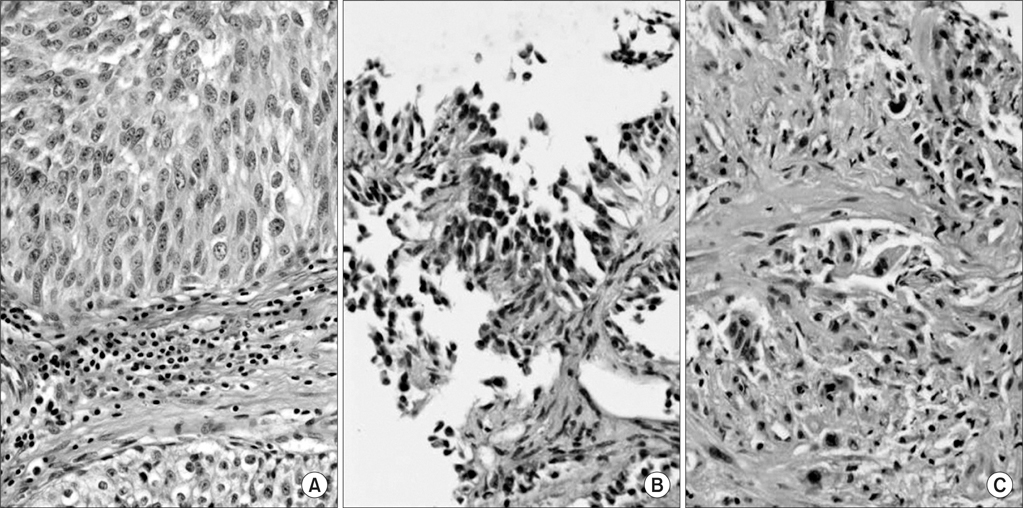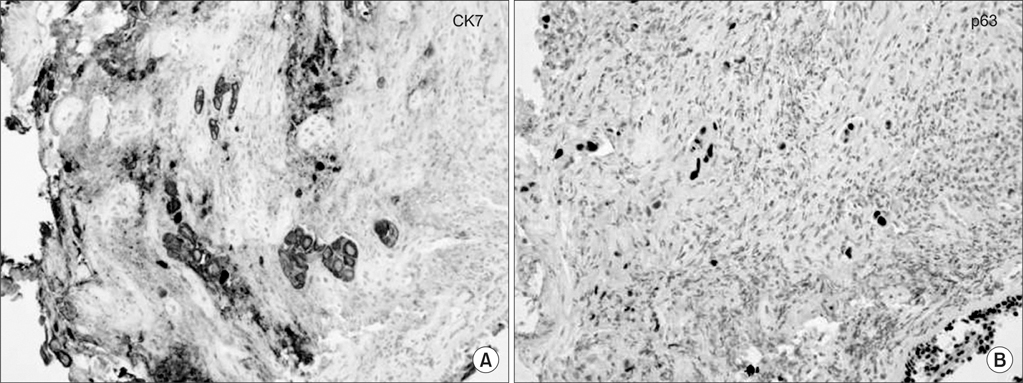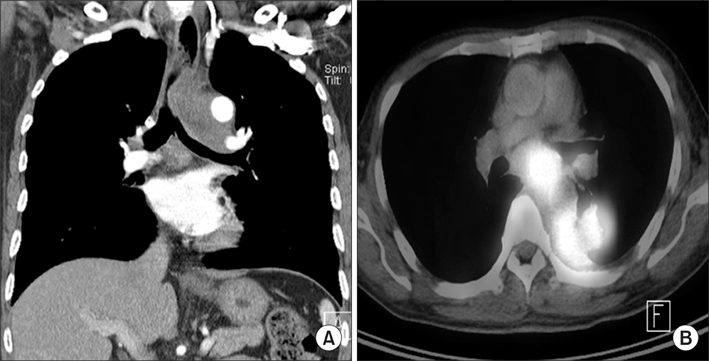Tuberc Respir Dis.
2013 Jul;75(1):32-35.
Late-Onset Distant Metastatic Upper Urinary Tract Urothelial Carcinoma Mimicking Lung Adenocarcinoma
- Affiliations
-
- 1Division of Pulmonary and Critical Care Medicine, Department of Internal Medicine, Inha University Hospital, Inha University School of Medicine, Incheon, Korea. hsnam@inha.ac.kr
- 2Department of Pathology, Inha University Hospital, Inha University School of Medicine, Incheon, Korea.
Abstract
- Urothelial carcinomas (UCs) can occur in the upper urinary tract or lower urinary tract. Upper urinary tract urothelial carcinoma (UUT-UC) is relatively a rare disease and accounts for only about 5% of UC cases. Sporadic cases of late-onset metastasis, associated with UC of the bladder, have occasionally been reported. In contrast, no late-onset distant metastatic UUT-UC without local recurrence has, to the best of our knowledge, been reported in the English literature. We report an extremely rare case of distant metastatic UC, mimicking lung adenocarcinoma that originated from UUT-UC 12 years previously.
Keyword
MeSH Terms
Figure
Reference
-
1. Roupret M, Zigeuner R, Palou J, Boehle A, Kaasinen E, Sylvester R, et al. European guidelines for the diagnosis and management of upper urinary tract urothelial cell carcinomas: 2011 update. Eur Urol. 2011; 59:584–594.2. Tawfiek ER, Bagley DH. Upper-tract transitional cell carcinoma. Urology. 1997; 50:321–329.3. Seymour JE, Malin JM Jr, Pierce JM Jr. Late metastases of a superficial transitional cell carcinoma of the bladder: report of a case. J Urol. 1972; 108:277–278.4. Dougherty DW, Gonsorcik VK, Harpster LE, Trussell JC, Drabick JJ. Superficial bladder cancer metastatic to the lungs: two case reports and review of the literature. Urology. 2009; 73:210.e3–210.e5.5. Hall MC, Womack S, Sagalowsky AI, Carmody T, Erickstad MD, Roehrborn CG. Prognostic factors, recurrence, and survival in transitional cell carcinoma of the upper urinary tract: a 30-year experience in 252 patients. Urology. 1998; 52:594–601.6. Sengelov L, Kamby C, von der Maase H. Pattern of metastases in relation to characteristics of primary tumor and treatment in patients with disseminated urothelial carcinoma. J Urol. 1996; 155:111–114.7. Munoz JJ, Ellison LM. Upper tract urothelial neoplasms: incidence and survival during the last 2 decades. J Urol. 2000; 164:1523–1525.8. Galsky MD, Hahn NM, Rosenberg J, Sonpavde G, Hutson T, Oh WK, et al. Treatment of patients with metastatic urothelial cancer "unfit" for Cisplatin-based chemotherapy. J Clin Oncol. 2011; 29:2432–2438.9. Amin MB. Histological variants of urothelial carcinoma: diagnostic, therapeutic and prognostic implications. Mod Pathol. 2009; 22:Suppl 2. S96–S118.10. Nigwekar P, Amin MB. The many faces of urothelial carcinoma: an update with an emphasis on recently described variants. Adv Anat Pathol. 2008; 15:218–233.11. Kaufmann O, Fietze E, Mengs J, Dietel M. Value of p63 and cytokeratin 5/6 as immunohistochemical markers for the differential diagnosis of poorly differentiated and undifferentiated carcinomas. Am J Clin Pathol. 2001; 116:823–830.12. Kunju LP, Mehra R, Snyder M, Shah RB. Prostate-specific antigen, high-molecular-weight cytokeratin (clone 34betaE12), and/or p63: an optimal immunohistochemical panel to distinguish poorly differentiated prostate adenocarcinoma from urothelial carcinoma. Am J Clin Pathol. 2006; 125:675–681.13. Mukhopadhyay S, Katzenstein AL. Subclassification of non-small cell lung carcinomas lacking morphologic differentiation on biopsy specimens: Utility of an immunohistochemical panel containing TTF-1, napsin A, p63, and CK5/6. Am J Surg Pathol. 2011; 35:15–25.14. Aguirre-Ghiso JA. Models, mechanisms and clinical evidence for cancer dormancy. Nat Rev Cancer. 2007; 7:834–846.
- Full Text Links
- Actions
-
Cited
- CITED
-
- Close
- Share
- Similar articles
-
- Urothelial Tumors of the Upper Urinary Tract: Multiplicity and Prognostic Variables
- Urothelial Tumors of the Upper Urinary Tract, 15 Cases
- A clinical analysis of the upper urinary tract transitional cell carcinoma and associated bladder tumor
- Histologically confirmed distant metastatic urothelial carcinoma from the urinary bladder: a retrospective review of one institution’s 20-year experience
- A Case of Zosterifom Cutaneous Metastatic Carcinoma




